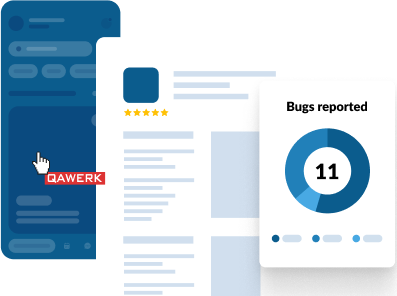We’ve come to a point when it’s time to look back and evaluate the results of our Bug Crawl initiative. With almost 200 apps tested for free, we can make some evidence-based conclusions and hopefully save thousands of mobile developers and QA engineers from repeating the same mistakes.
If we are just meeting, you probably wonder what Bug Crawl is. Say no more; we’ll break it down for you. Back in 2016, while polishing our mission and vision, a brilliant idea struck our mind: we wanted to make the world a better place by reducing the number of bugs in software.
Apart from helping startups and well-established tech companies eliminate bugs in application before they get noticed by a broader audience of consumers, Bug Crawl allows us to keep our fingers on the pulse of the latest development trends. Moreover, we continually grow our expertise in manual testing, which we then happily apply to commercial projects.
Needless to say, Bug Crawl is a great way to forge partnerships – this is exactly how we met one of our most successful clients – Unfold, supporting them all the way from a crashy story-maker to a billion-user platform, drawing the attention of big names like Google, Apple, and Squarespace.
Want to repeat Unfold’s success? Wait no longer and request your free bug report now. If you are here to learn more about common yet critical bugs in mobile apps, please read on.
In this article, we’ll cover:
True Cost of Bugs in Mobile Apps
Before we jump straight into examples of popular bugs, let’s rewind a bit and remind ourselves why bugs matter and what damage they can inflict if left unattended. Yes, we all know bug-free products do not exist; even the coolest companies struggle with app bugs. However, what distinguishes a remarkable company from a mediocre one is the number and severity of bugs in their software and their willingness to invest in continuous quality assurance.
It is estimated that software bugs cost the US economy some 2.5 trillion dollars each year. Let’s dive deeper into what factors contribute to this horrendous number.
High Customer Churn
Customers churn for many reasons, yet if we look closely into mobile app usage data, it all becomes clear. Smartphone users don’t just abandon an app on a whim; their choices are rational and motivated by some tangible benefits. For instance, about 40% of US-based mobile users will uninstall an app if it has too many software issues and go to a competitor that has polished their product, made it intuitive, and battery-friendly.
What’s even more nerve-wracking for mobile app creators is that they have about one month to fix all the glitches before about 60% of their customers churn. And that first impression, yes, it matters, especially considering 25% of mobile apps are used only once! What statistic is missing is how many mistakes the user can tolerate, but you certainly don’t want to be the one gathering this data and turning your consumers into beta testers.
Damaged Brand Image
Apart from instant uninstalls incurring some direct losses, bugs in mobile apps also cause damage hiding deep under the surface.
It’s impossible to count how many people saw a bad review on Google Play or App Store and decided to search for a better-performing app. It is also unreasonable to underestimate the power of word of mouth. When we feel sad or mistreated, we want all the world to know about the injustice we had to live through, be it payment not going through or a song impossible to pause. And the first people we contact are family and friends, who, believe it or not, will spread the word further.
The easiest way to illustrate the destructive effect of negative reviews is to look at the losses some game publishers like CD Projekt Red and Blizzard had to suffer because of numerous glitches in their latest games – Cyberpunk 77 and Warcraft III: Reforged. The same experience can be applied to mobile games and apps: users will request refunds, unsubscribe, and alert their peers not to waste time and money on hastily made products.
Broken Investment Deals
Many startups heavily depend on investments to be able to develop their products further. However, having a great product idea is not enough for a persuasive pitch. Investors will dig deeper and look for some proof that the app under discussion actually fills the void in a certain market niche and is used by real people.
Once again, it all comes down to the number of installs and positive reviews. If the app crashes, freezes, or doesn’t save the user’s preferences, it is doomed to harsh criticism and a small customer base, if any.
What’s even more important for investors is seeing the product’s bright future, and the latter is rarely achieved with sporadic quality assurance. Therefore, inviting an external tech advisor with well-established software testing expertise to thoroughly scan your app for bugs is a reasonable step to take for startups and scaleups hoping to secure their investment deals.
iOS vs Android App: Which Has More Bugs?
Our Bug Crawl portfolio lists both iOS and Android apps, and of course, any business owner still deciding on the platform for their app will ask us which is faster and cheaper to build, easier to maintain, and has less app bugs.
While there is no universal answer as one should consider factors like target audience and revenue goals, one thing we know for sure: Android apps tend to have more bugs and thus require a double amount of QA effort. Why? Well, there are several reasons:
- Device Fragmentation. Yes, you go big; you go for some 131.2 million Android users; however, the one thing you forget is that they all use different devices. Android gadgets come in different sizes and with different screen resolutions, leave alone the hardware differences. This requires more research into which device models are more popular and more development effort to optimize the app to a broader range of devices.
- OS Fragmentation. Being open source software, Android has been modified countless times to fit different smartphone manufacturers’ commercial goals. As a result, nowadays, we have a multitude of different Android OSs, which spawn plentiful compatibility issues. On top of that, Android users are reluctant to update their software, with about 50% of them using two-year-old versions. The latter is a huge security concern and the main reason why their Android apps have poor performance.
- Lax Approval Process. Anyone dealing in the app development niche knows for a fact that getting an app into Google Play is much easier compared to App Store. While some may view it as a significant advantage, real life proves it wrong. The absence of stringent policies gives developers the freedom to experiment with their ideas; however, it increases the chances of releasing a buggy product to market, which will inevitably result in negative reviews.
Since these challenges have been major pain points in Android app development and testing, software engineers and testers always try out new tools that can make their lives just a little bit easier. For example, Bug Hunter is one of such tools: it has the functionality to address device and OS fragmentation as well as check UI components and their alignment with better accuracy.
Top 10 Сommon Bugs in Mobile Apps
Although Android apps are more prone to bugs, iOS ones are not immune to them. We’ve encountered the same types of bugs on both platforms, so let’s go over them one by one and see how they affect the user journey of thousands and even millions of real consumers.
Crashes & Freezes
Factors affecting mobile app performance are indeed plentiful. Each case is unique, and you have to dig deeper to get to the root cause of such behavior. It may be a network error, insufficient storage, or outdated coding practices that have turned your app into Frankenstein’s monster.
We crunched the numbers, and over 2020 – beginning 2021, we witnessed 11 apps out of 102 crash or freeze. Is this a small number? You decide. However, what you need to keep in mind is that this is just a tiny fraction of what is going on in real life. The apps we’ve recently tested already have a decent customer base, which means they’ve already done a bulk of testing. Obviously, the crash rate for newly released products stands much higher.
In our experience, apps crashed when the user:
- Restarted the app
- Tried to identify their current location
- Tried to use a filter
- Tapped a button, back arrow, or icon
- Tried to save some tracked data
- Uploaded a file larger than the app can handle
- Navigated through the app with the Internet off
Let’s take a look at some real-life examples of app crashes.
Disclaimer: The bugs highlighted in our reports have a short lifespan; therefore, they are probably fixed by the time you read this article. Our major goal is to alert publishers to the dangers of insufficient QA, help them eliminate critical bugs early on, and thus strengthen their product competitiveness. All of the companies listed in our Bug Crawl portfolio are promising startups and scaleups we highly support.

Critical
- Open the app.
- Tap the “Look” button in the menu.
- Tap the “Search” field.
- Tap the “Current Location” button.
Huawei Nexus 6P + Android 8.1.0
The app crashes.
A window pop-up opens for the user to choose from a range of location variants.
Issues with Buttons and Links
They don’t work. That’s it. There is nothing to add here. Actually, sometimes you just need to tap twice for the button to work; sometimes you’ll immediately know that it’s inactive by seeing a random error message (which is still better than repeatedly clicking for nothing). And sometimes, you’ll be deported to the profile page or the home screen even though you just wanted to go a single step back, not necessarily start it all over.
We’re not talking only about well-hidden buttons that are rarely used and therefore inflict minimum damage if broken. We came across some major bugs, such as being unable to log in because the Forgot Password button won’t respond. One more serious trouble we witnessed is when the button is missing altogether. For example, there is a payment module but no option to add funds to one’s digital wallet.
Same story with links: they either contain no URL at all or redirect to a wrong page. Let’s have a closer look at some improper button behavior using these apps as an example.

Major
- Launch the app.
- Tap on the “Wallet” icon.
- Take a look at the upper-right corner of the screen.
- Pay attention to the next result.
iPad + iOS 10.3.3
“Add Funds” button is missing on the “Wallet” section.
“Add Funds” button is shown on the “Wallet” section and the user is able to proceed with funds transfer.
User Profile Bugs
It all starts with creating one. If you’re a real user interested in the app, you’ll obviously start with the sign-up stage, filling out all the input forms with relevant data. However, if you’re a professional mobile app tester like us, you’ll jump straight into checking validation rules. The latter are often ignored, to the extent one can use spaces virtually for everything – their first name, last name, password.
The second most common scenario is the missing validation for emails or just the default one scanning the address only for the presence of the @ symbol. Such a negligent attitude to the user’s security spawns an array of other issues, such as bulk account creation with fake emails, the inability for the user to instantly restore a password, and a distorted customer base.
Another portion of bugs relates to the sign-in with Google or Apple ID. Although not every app can boast this feature, those who did implement it faced some hardships. In most cases, the attempt resulted in an error message; however, we also documented quite an amusing case – when already two Android apps offered sign-in with Apple.

Minor
- Launch the app.
- Tap the Settings gear in the top right corner of the screen.
- Scroll down to the “Link my Apple Account” button and tap it.
Vivo U3x + Android 9, Funtouch OS 9.1
The following notification is displayed: “Your request could not be completed because of an error. Please try again later.”
Remove from Android a possibility to add any Apple account.
User Preferences Not Saved
Nowadays, it’s impossible to imagine a competitive app without allowing users to save favorites or customize content to their liking. Indeed, developing functionality for saving some user preferences is a surefire way to make each app journey more personalized. If only everything worked as intended.
As for the bugs we personally encountered while testing user preferences, here are bugs examples of unfortunate scenarios we observed:
- Stores / projects marked as favorite / important weren’t highlighted as such
- Custom order of items in the list was lost after refreshing the app
- Latest browsed page was not saved when the user hid the app
- Newly created folders show up only after reloading
- No confirmation if changes to settings were applied or not

Major
The user is logged in.
- Open the app.
- Tap the “Explore” button.
- Select any project.
- Tap the “Star” button.
- Navigate to the “Explore” page again.
Huawei Nexus 6P + Android 8.0.0
The project’s status is the same; it is not marked as starred.
The project’s status is updated.
Not Optimized for Landscape
Testing how the app looks and performs with the landscape orientation should be an obligatory point in the app publishers’ testing checklist. Of course, some app developers choose to lock the orientation to portrait and thus kill two birds with one stone – avoid nasty bugs and save up on the development effort. However, it’s not always a good idea in terms of inclusivity and accessibility since some people may find the portrait orientation more convenient.
Most of the bugs we documented while rotating apps to landscape were UI imperfections. While some of them were hardly noticeable, others posed a major inconvenience for the user.

Major
The user is logged in.
- Open the app.
- Navigate to the “Home” page.
- Change the orientation to landscape.
Huawei Nexus 6P + Android 8.1.0
The view of the “Home”page blocks is broken; the user is not able to swipe them.
The view of the main blocks is without defects and the user can swipe the blocks in the landscape mode.
UI Flaws
This category is probably the most abundant of bugs in mobile application, and we get why. When it comes to Android devices, one can easily get lost in the number of different screen sizes and pixel densities, and it’s a real challenge to accommodate all those compatibility aspects. With iOS, things are pretty straightforward, yet we noticed a tendency that some developers tend to neglect older models, thus exposing a segment of consumers to a slightly worse service.
The most widespread scenario is, of course, when one UI element overlaps another one, be it an icon, a button, or an order price. Other common bugs include:
- Cropped titles and images
- Improper email wrapping
- Overflowing content
- Background color matching input text
- Pop-ups staying visible for a long time
- Misplaced cursor
- Logo flickering upon tap
- Incorrect page scrolling
- Elements changing their position upon tap

Major
- Launch HonkMobile app.
- Once the home screen is fully loaded, proceed to the next step.
- Tap the burger menu in the upper-left corner of the screen.
- Tap “Payment”.
- Tap “Add Payment Method”.
- Select “Credit or Debit” by tapping it.
- Tap “Card number” field and type a random 16-digit number (EG: 1111 2222 3333 4444).
- Scroll up a little bit.
- In the upper-left corner, tap “X” to close this section.
- Take a look at the next result.
iPad 4 + iOS 10.3.3
After closing “Credit or Debit” screen, iOS default keyboard remains open.
iOS default keyboard disappears after tapping “X” to close “Credit or Debit” section.
Useless Filters
Sorting and filtering options are undeniable must-haves of modern apps, and their purpose is obvious: saving users’ time and making their browsing effortless yet engaging. Sounds cool, right? What if we tell you that sometimes, just sometimes, filters can bring more trouble than use. It mostly happens when the testing process is less comprehensive than it should be.
While some bugs associated with filters can be insignificant, others can create a negative first impression and eventual loss of a consumer. For example, autocomplete suggestions not adapting to the user’s input is a much more tolerable bug than a broken filter in a dating app that was supposed to sort male and female accounts.

Major
- Launch “Spotify for Artists” app.
- Sign into an app by using existing account (User must have a verified artist’s profile).
- Once you’ve successfully logged in, tap on the “Music” icon (Take a look at the attached video).
- Tap upon the drop-down filter.
- In that drop-down filter select “Listeners” << “Sort by…”
5.1 In the “Choose time period…” select “All time”.
5.2 Tap upon the drop-down filter and change selection from “All-time” to “Since 2015” or “Last 28 days”.
- Take a look at the next result.
iPhone 8 + iOS 13.6
Result of sorting with applied “All-time” filter sorted by “Saves” returns zero value.
Result of sorting regarding “Listeners” must return an actual quantity.
Malfunctioning Audio and Video
Audio and video materials are consumed far more often than any other type of content. For this reason, so many app developers decide to include audio and video features in their products. Needless to say, it’s a great way to keep consumers entertained, educated, and engaged. For certain categories of apps with bugs, such as mediation apps, mobile podcasts, workouts, and e-learning, audio and video are part of the core functionality and therefore require impeccable implementation.
Looking back at the apps we’ve tested, mobile app developers and testers overlooked the following:
- Not all tutorials could be played
- Videos did not play from the very start
- The playback option didn’t work
- Promo video was not optimized for the mobile screen
- Song was still playing after the user tapped to pause it

Major
- Launch the app.
- Tap “Recommended”.
- Open the video “Creating a Connection Culture”.
- Tap “Play”.
- The video begins to play.
- Enable the mode “Audio only”.
Huawei P20 lite + Android 9, EMUI v. 9.1.0.352
The video doesn’t play in the mode “Audio only”.
The video plays in the mode “Audio only”.
Unfriendly Error Messages
No matter how many tutorials are there on writing clear, user-friendly error messages, we keep seeing apps whose creators didn’t take error handling seriously. While error messages are not something users see every second minute, they may also affect the overall user’s perception of the app. Naturally, a pop-up with negative wording and no immediate solution can hardly evoke any positive feelings in the user, rather irritation and confusion. While programmers have no trouble understanding technical jargon, an average user will find these straight-from-the-server alerts of little help.
Let’s have a look at some unfriendly error messages we encountered:
- Something went wrong
- Data not found
- Requesting delivery
- Please try again. If the issue persists, reach out to support
- Error loading data
- Sorry, there was an error during the login process

Major
- Open the app.
- Find an epaper for purchase.
- Turn on the airplane mode on the device.
- Tap “Open”.
iPhone XS + iOS 14.2
The “Requesting Delivery” message pops up and disappears.
The error message “Please, check your Internet connection” pops up.
Incomplete Localization
What business owner doesn’t dream of a global audience? Just the thought of knowing that your product is used far beyond your home country is heart-warming; leave alone the monetary gains. While the idea of building an app available in multiple languages is more than reasonable, its implementation is often not that smooth. We understand that releasing a product within the set timeframe may require some triaging in terms of what bugs in mobile application should be eliminated before the launch and what are acceptable and will be removed later. Nevertheless, sloppy localization is what users notice on the spot. It’s believed the style is in the details, so is the software quality: it’s in the details.
Therefore, if you have enough time to polish your app, be sure to check if:
- Layout is in order when the user switches to a different language
- Privacy Policy & Terms and Conditions are fully translated (these are often neglected as no one reads them, right?)
- Page content is translated, not just page titles
- All buttons are localized
Major
- Launch the app.
- Tap the “Settings” button.
- In the newly appeared menu, switch the language from English to Thai.
- Pay attention to the next result.
iPhone SE 1st gen + iOS 14.3
All the language symbols turned into boxed question marks.
The app’s content is translated to Thai and displayed in Thai.
What Bug Crawl Participants Say
We are proud to know that our Bug Crawl initiative brings real value to businesses the world over. While mastering our expertise in mobile testing, we also get to help new market entrants and well-established companies fine-tune their software, grow their brand authority, and as a result, win the hearts of new consumers. We highly appreciate all the positive feedback we received from Bug Crawl participants, and we are thrilled to share it with you.
“Thank you very much for the bug crawl! It looks like a great initiative. To be honest, that’s one of the best bug reports we’ve ever had, it’s very clear. However we do our best to keep the QA inside the team to empower developers to ship bugless features. Thank you nevertheless!”
“Thank you for your kind words and for sharing the report! Within the last month, we’ve launched v2.0 of the app which has addressed the bugs you’ve listed in your report as well as introduced an updated UX. We appreciate you and your team’s work on identifying these issues and hope you enjoy the update. Feel free to reach out if you come across any additional bugs or vulnerabilities!”
“Thank you for submitting the bug information in our application. We have fixed the bugs found. We always prioritize quality and safety in our applications and we really appreciate what you have reported. Thank you!”
Final Thoughts
There is no such thing as 100% bug-free apps. Bugs are part of the software development cycle, and they’ll find a backdoor to surprise you. At the same time, a buggy app is not something users deserve, especially considering how competitive the mobile app market is. A happy medium here would be investing in comprehensive software testing to manage the available resources wisely. Having all the bugs reported at your disposal clarifies what areas require immediate intervention and what aspects can wait. What’s even more important is letting an external party evaluate your app: that’s when major issues get revealed.
Want to ensure your mobile app is launch-ready?
Submit your mobile app for free testing as part of our Bug Crawl program. Our expert QA team will test your app to help uncover the bugs you might have missed. Request our Bug Crawl test to get a detailed bug report and fix issues before the launch day.





